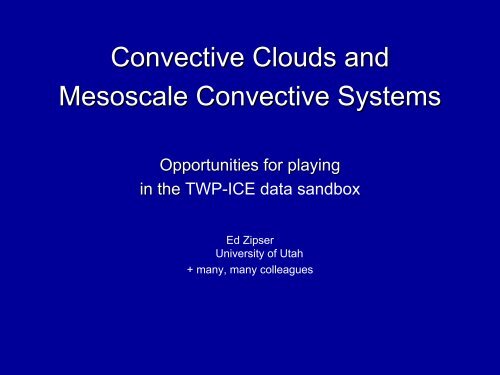Convective Clouds and Mesoscale Convective Systems
Convective Clouds and Mesoscale Convective Systems
Convective Clouds and Mesoscale Convective Systems
- No tags were found...
You also want an ePaper? Increase the reach of your titles
YUMPU automatically turns print PDFs into web optimized ePapers that Google loves.
<strong>Convective</strong> <strong>Clouds</strong> <strong>and</strong><br />
<strong>Mesoscale</strong> <strong>Convective</strong> <strong>Systems</strong><br />
Opportunities for playing<br />
in the TWP-ICE data s<strong>and</strong>box<br />
Ed Zipser<br />
University of Utah<br />
+ many, many colleagues
Intense convection using 4 quasi-independent proxies from 8 years of TRMM data (after Zipser et al. BAMS Aug 06)
Taking a closer look at the 40 dBZ tops (purple > 14 km, black > 17 km)<br />
• There really is a l<strong>and</strong>-ocean difference in convective intensity<br />
• Hector (Tiwi Isl<strong>and</strong>s) is more like Indonesia than the rare monsters south<br />
of Darwin.
Intense convection proxies are indeed concentrated over l<strong>and</strong>, but careful<br />
comparison shows that l<strong>and</strong> <strong>and</strong> ocean meet different proxies with different<br />
frequencies. This map is for relative frequency of moderate strength proxies.
This map is for relative frequency of moderately large ice water path (85 GHz Tb < 160K),<br />
showing mainly a longer season of storms over Indonesia compared with Australia.
Top: Relative frequency of 40 dBZ tops above 7 km (shorter season in Australia).<br />
Bottom: Difference between relative frequency of IWP <strong>and</strong> radar proxies.<br />
Positive (yellow) more “maritime”, negative (green) more “continental”.
(extras)<br />
TRMM view of MCS 23 UTC on 23 January. Huge area of IR tops < 196K with spots<br />
below 184K. (But even strongest convection barely makes moderate intensity category)
450-km cross-section through MCS. Some very high tops but moderate intensity.<br />
(vertical resolution at edge of swath is 1.5 km so bright b<strong>and</strong> is not so prominent)
Some science questions<br />
Issue: <strong>Convective</strong> intensity is known to have a poor relationship to<br />
CAPE- so what environmental conditions have a better relationship<br />
Possibility: CAPE is related to “maximum potential intensity” (MPI),<br />
<strong>and</strong><br />
The fraction of MPI actually achieved depends upon the magnitude of<br />
low-level forcing (reducing entrainment)<br />
• TWP-ICE may have one of the best datasets anywhere for<br />
cataloging proxies for convective intensity, <strong>and</strong> for characterizing the<br />
environment<br />
• OBVIOUSLY, we should plan on collaborative studies for linking<br />
convective core properties to the anvil cirrus that they produce.
• The 23 January MCS is one of the best examples<br />
of upscale growth of a circulation ever observed!<br />
• It's squarely in the middle of a superb sounding<br />
array <strong>and</strong><br />
• It has C-POL radar for study of convective<br />
intensity, microphysical properties, <strong>and</strong> winds<br />
while it's happening.<br />
• We should jump all over this case.
• Planetary Boundary Layer “recovery” after convective<br />
downdrafts have created a cold pool<br />
• Some good opportunities exist for getting pre-convective<br />
environments with Dornier data, followed by post-storm<br />
conditions at ridiculously low levels from the 4D flights<br />
4D= “daredevil death-defying Dimona”


